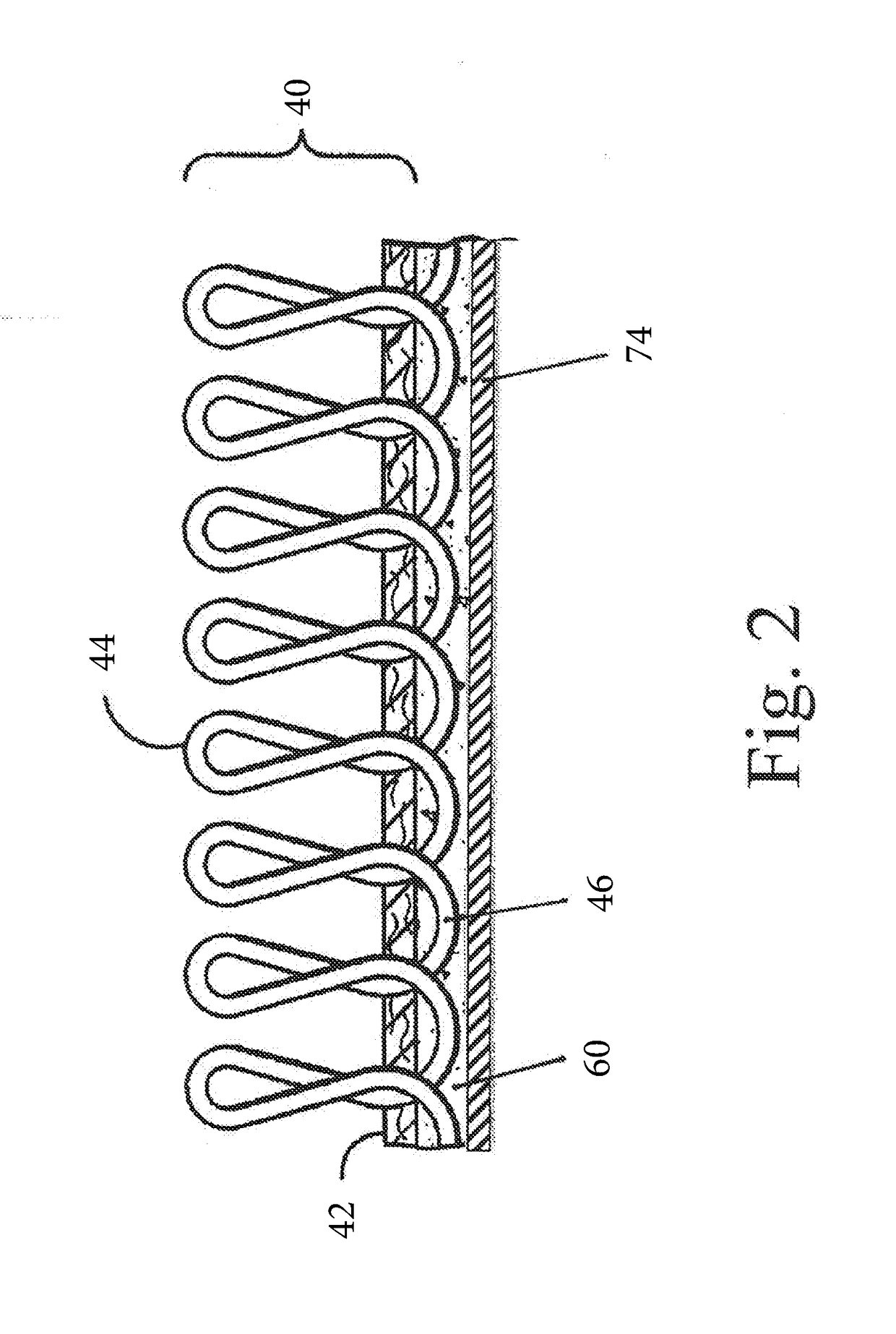Method of applying a theromplastic polymer coating
- Summary
- Abstract
- Description
- Claims
- Application Information
AI Technical Summary
Benefits of technology
Problems solved by technology
Method used
Image
Examples
example 1
[0044]A tufted carpet product is prepared in accordance with the present invention. The carpet comprises a 0.5 inch pile height polyester face fiber tufted into a woven polypropylene primary backing. An aqueous dispersion of thermoplastic polymer particles is prepared having the following formulation as shown in Table 2:
TABLE 2IngredientPercent by WeightWater69.3Dispersion agent (xanthan gum)0.2Polyethylene particles (having an average30.0particle size of 80 microns)Sodium lauryl sulfate0.5
[0045]The carpet is processed in accordance with the present invention as described above. The aqueous dispersion of Table 2 is converted to a foam in a frothing machine. The foamed aqueous dispersion of thermoplastic polymer particles is applied to the carpet primary backing and formed into a uniform layer at the rate of 10 ounces per square yard and the resulting layer is approximately 0.25 inches thick. The foam coated polypropylene primary backing is heated in a heated oven at a temperature of...
example 2
[0046]A synthetic turf product is prepared in accordance with the present invention. The synthetic turf comprises a 2.5 inch pile height polyethylene face fiber tufted into a woven polypropylene primary backing. An aqueous dispersion of thermoplastic polymer particles is prepared having the formulation as shown in Table 2 above.
[0047]The synthetic turf is processed in accordance with the present invention as described above. The aqueous dispersion of Table 2 is converted to a foam in a frothing machine. The foamed aqueous dispersion of thermoplastic polymer particles is applied to the synthetic turf polypropylene primary backing and formed into a uniform layer at the rate of 16 ounces per square yard and the resulting layer is approximately 0.25 inches thick. The foam coated polypropylene primary backing is heated in a heated oven at a temperature of 212° F. for a period of 4 minutes until the aqueous dispersion is substantially dry. In the heated oven the foam quickly collapses and...
example 3
[0048]A 2.5 inch pile height polyethylene face fiber synthetic turf with a polypropylene woven primary and a thermoset polyurethane precoat is selected for testing. The synthetic turf is comprised of 51% by weight polyethylene, 14% by weight polypropylene and 35% by weight thermoset polyurethane. The synthetic turf is removed from a sports facility using a Turf Muncher to strip the turf from the field, 95% by weight of the infill material is remove and the turf is rolled into a roll. The turf roll is cut into strips 36 inches wide. The strips are fed into a Series 14 Grinder from Jordon Reduction Solutions of Birmingham, Ala. where the turf strips are ground / cut into particles having a maximum dimension of ⅜ inch. The size reduced synthetic turf is processed through a 4 inch single screw extruder with a 26:1 L / D at 400° F., which is a sufficient temperature to melt the thermoplastic material from which the synthetic turf is made. The extruder is equipped with a 300 horsepower electr...
PUM
| Property | Measurement | Unit |
|---|---|---|
| Temperature | aaaaa | aaaaa |
| Temperature | aaaaa | aaaaa |
| Temperature | aaaaa | aaaaa |
Abstract
Description
Claims
Application Information
 Login to view more
Login to view more - R&D Engineer
- R&D Manager
- IP Professional
- Industry Leading Data Capabilities
- Powerful AI technology
- Patent DNA Extraction
Browse by: Latest US Patents, China's latest patents, Technical Efficacy Thesaurus, Application Domain, Technology Topic.
© 2024 PatSnap. All rights reserved.Legal|Privacy policy|Modern Slavery Act Transparency Statement|Sitemap



